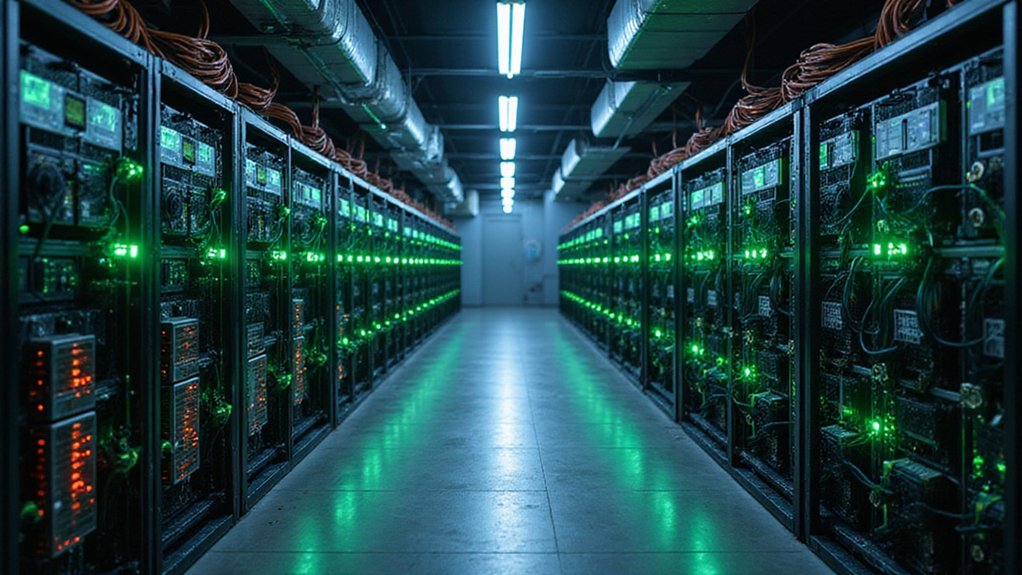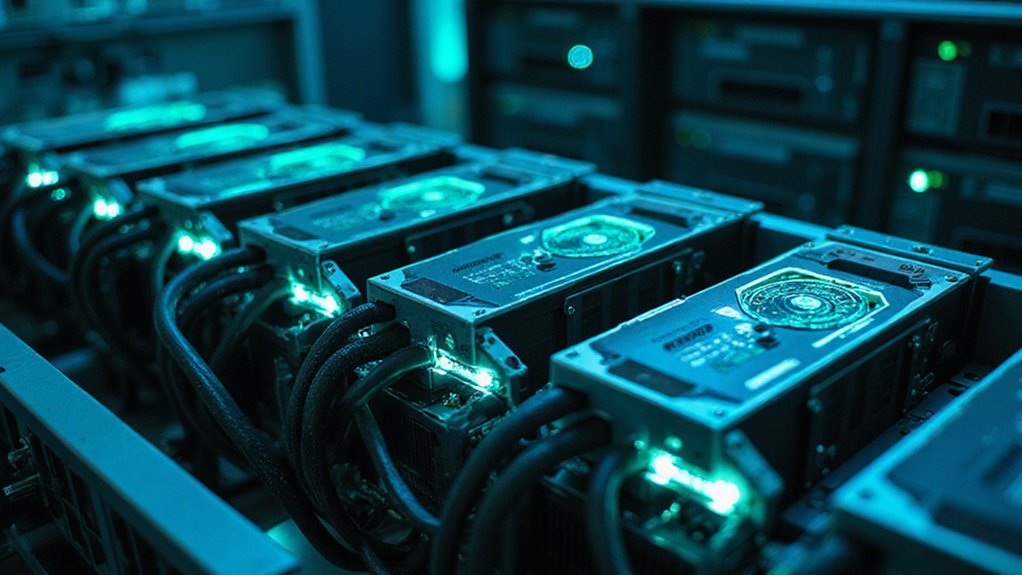Parallel processing revolutionizes cryptocurrency mining by enabling simultaneous calculations rather than sequential operations. Modern GPUs and ASICs harness thousands of cores to solve complex cryptographic puzzles at industrial scale, transforming once-hobbyist activities into computational powerhouses. This concurrent approach not only increases throughput and mining rewards but strengthens blockchain security by making fraudulent alterations prohibitively expensive. Despite requiring significant capital investment and raising environmental concerns, parallel architectures remain cryptocurrency’s computational backbone—the invisible force behind those ever-climbing hash rates.

The relentless quest for computational efficiency in cryptocurrency mining has propelled parallel processing to the forefront of blockchain technology, transforming what was once a hobbyist pursuit into an industrial-scale operation requiring specialized hardware and sophisticated techniques.
Cryptocurrency mining fundamentally relies on solving complex mathematical problems—a task for which parallel execution offers significant advantages over sequential processing.
This computational approach allows numerous calculations to be performed simultaneously rather than sequentially, dramatically increasing throughput and efficiency.
Parallel execution unleashes computational potential through simultaneous calculation, yielding unprecedented throughput efficiencies in blockchain operations.
The hardware ecosystem supporting this parallel paradigm has evolved considerably.
Graphics Processing Units (GPUs) emerging as the dominant force due to their architecture featuring thousands of cores designed explicitly for concurrent operations.
Application-Specific Integrated Circuits (ASICs), purpose-built for mining specific cryptocurrencies, represent the apex of this specialization curve—offering unparalleled hash rates but at considerable capital expense.
The most advanced ASIC miners like the Bitmain Antminer S21 series have revolutionized mining efficiency with their exceptional hash rates and computing power.
The humble CPU, with its limited parallel capabilities, has largely been relegated to mining’s dustbin of history (save for a few memory-hard algorithms designed specifically to resist ASIC implementation).
The advantages of parallel processing extend beyond mere computational efficiency.
Mining operations leveraging parallel architectures enjoy enhanced scalability during demand fluctuations, reduced transaction confirmation latency, and—perhaps most compelling to participants—increased probability of successful block validation with its attendant rewards.
The UTXO (Unspent Transaction Output) model utilized by Bitcoin and several other cryptocurrencies particularly benefits from parallel execution, as independent transactions can be validated concurrently without sequential dependencies.
These mining operations contribute to the overall ecosystem by maintaining network security through computational power that makes fraudulent alterations prohibitively expensive.
The shift toward parallel execution in blockchains addresses the throughput limitations of sequential transaction processing seen in traditional blockchain designs like Ethereum’s EVM.
This technological bounty comes with corresponding challenges, however.
Parallel mining infrastructure demands significant initial investment, sophisticated thermal management systems, and substantial electricity consumption—the latter becoming an increasingly contentious point as mining’s environmental footprint grows.¹
Network stability and load balancing present ongoing operational complexities, while the technical expertise required to optimize parallel systems exceeds that needed for traditional computing environments.
¹The energy consumption debate has, quite reasonably, sparked interest in alternative consensus mechanisms requiring less computational brute force.
Frequently Asked Questions
How Does Parallel Processing Impact Cryptocurrency Mining Energy Consumption?
Parallel processing introduces a paradoxical dynamic in cryptocurrency mining’s energy landscape.
While specialized hardware (GPUs and ASICs) delivers substantial efficiency gains—processing multiple operations simultaneously and reducing joules per terahash—the resulting cost advantage ironically encourages expanded mining operations.
This technological efficiency fails to curtail overall consumption, as Bitcoin’s staggering 110 TWh annual appetite (0.55% of global electricity) demonstrates.
The efficiency improvements merely moderate what would otherwise be catastrophically higher energy demands.
Can Parallel Processing Be Used for Sustainable Mining Alternatives?
Parallel processing indeed forms the backbone of sustainable mining alternatives, offering a pathway beyond traditional energy-guzzling approaches.
FPGA technology—that middle child of mining hardware—leverages parallelism while consuming substantially less electricity than GPU farms.
These reprogrammable devices maintain algorithmic flexibility (unlike their single-minded ASIC siblings) while delivering comparable hash rates.
Moreover, parallel architecture enables the development of optimized code that can reduce computational redundancy, allowing miners to extract maximum value from each watt consumed—a not-insignificant consideration in today’s environmentally-conscious marketplace.
What Security Risks Accompany Parallel Mining Operations?
Parallel mining operations introduce multifaceted security vulnerabilities including remote code execution exploits targeting GPU resources, deserialization weaknesses in AI/ML workloads, and evasive malware techniques that disable protective measures.
These attacks often blend seamlessly with legitimate processing tasks, complicating detection while draining computational resources, electricity, and hardware lifespan.
Supply chain compromises and application vulnerabilities further exacerbate risks, potentially enabling unauthorized cryptojacking that monopolizes system resources—all while maintaining a low profile that frustrates conventional monitoring approaches.
How Do Mining Pools Implement Parallel Processing Technology?
Mining pools implement parallel processing through multi-threaded software that distributes computational work across numerous machines.
Each participant receives unique portions of the hashing puzzle, preventing duplicate efforts while pool servers coordinate this distribution, track contributions, and validate solutions.
The architecture typically employs ASIC or GPU clustering with load-balancing algorithms to optimize resource allocation.
Sophisticated pools implement hierarchical structures—with master nodes supervising regional sub-pools—effectively creating a distributed supercomputer whose collective might exceeds the sum of its parts.
Will Quantum Computing Replace Current Parallel Processing Mining Methods?
Quantum computing is unlikely to replace current parallel processing mining methods in the foreseeable future.
Despite Grover’s algorithm‘s theoretical advantage of halving block discovery time, quantum systems face prohibitive energy requirements, astronomical costs, and significant technological hurdles.
The sheer scale needed to compete with established classical mining infrastructure remains implausible.
Rather than replacement, we’ll likely see a gradual evolution of mining technology with quantum-resistant algorithms emerging as preventative measures against potential cryptographic vulnerabilities.









